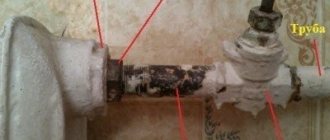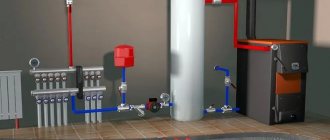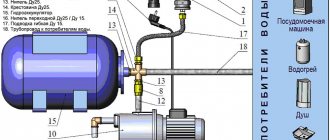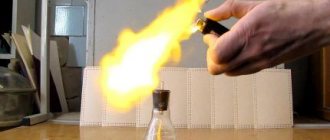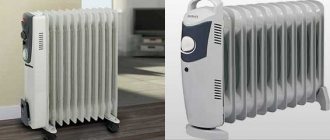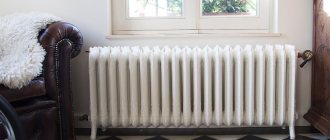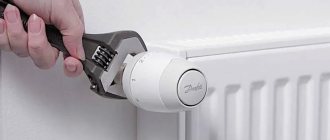A device such as a thermal head for a heating radiator is designed to regulate the heating temperature. With its help, you can use coolant more efficiently and save money.
Guaranteed effect from use - the right choice. To do this, you need to have as much information as possible about these devices.
From this article you will learn about the existing types of thermal heads, their design, operating principle and rules for installing them on radiators. We will also present the main criteria influencing the choice and briefly consider the best manufacturers of such equipment.
Is it worth installing thermal heads on heating radiators?
The purchase and installation of the device is justified when heating small rooms. In an apartment or garage, when used correctly, the device provides the best savings. For larger rooms where several radiators operate, purchasing separate thermal heads is not practical. It is more profitable to assemble them into a single circuit by installing a common wall thermostat.
Installation on old-style cast iron heating radiators is also not justified. Unlike bimetallic or aluminum analogues, such batteries take longer to heat up and cool down and accumulate heat better. Due to the increased inertia, the thermal head becomes less efficient.
Common Mistakes
Correct installation requires attentiveness from the master at every stage of work in order to avoid mistakes. The most common problem is the vertical position of the head. This leads to the fact that the room stops heating, since the thermostat itself heats up from the incoming air.
Often the wrong installation location is chosen. You cannot install the regulator at a point where the air temperature is very different from the average in the room. Due to the wrong choice of installation location, the use of a thermal head loses its meaning.
The operating principle of a thermal head for a heating radiator
The task of the thermostat is to control the heating of the battery when the air temperature in the room changes. The operating procedure of all autonomous thermal heads is based on the internal structure. Inside the device body there is a bellows - a corrugated container with a heat-sensitive substance.
Operating principle of the thermal head:
- The heated air acts on the composition, and the bellows begins to expand.
- Due to the corrugated structure, the container itself also increases in volume.
- The expansion sets the rod in motion, which gradually limits the passage of coolant into the radiator.
- The throughput decreases, the temperature of the heating radiator drops.
- The heating is weakened, the air cools.
- Cooling causes the bellows to contract, returning the rod to its original position.
- The coolant supply is resumed with the same force.
Control of device operation differs for different types of models. Each type has its own accuracy of adjustment of the radiator thermal head, ease of use and cost.
The divisions determine the limit of movement of the rod
Advantages and disadvantages
The advantages of installing thermostatic valves in the heating system include the following factors:
- Energy independence of the device.
- Compactness.
- High precision temperature control.
- Easy to operate and highly reliable.
- Aesthetic appearance.
- The optimal combination of price and functionality.
The disadvantages of using thermostatic valves are:
- Difficulty setting up.
- There is a danger of the thermal head malfunctioning under the influence of a draft or a nearby stove.
Types of radiator thermal heads
Battery thermostats are classified according to two factors. The first is a heat-sensitive compound in the bellows. Filling can be liquid or gas-filled. The latter, due to their lower inertia, are faster in operation. The second principle of separation is based on setting and control - manual, mechanical or electronic.
Manual thermal heads
They are characterized by a simple design and accessibility. They are a modification of a conventional tap. The regulator shows a scale with divisions corresponding to temperature. Allows you to change the temperature of the heating radiator to an exact value instead of an abstract value, as happens with a standard tap.
Devices of this type have several disadvantages. You have to adjust the heating manually, based on your own feelings. It is impossible to change the temperature during sleep and outdoors. Also, during active use, the moving parts of the valve quickly fail and may require replacement of the entire structure.
Advice! After the end of the heating season, the device is removed to avoid sticking of the moving elements.
Mechanical
Provide control of room temperature in autonomous mode. The moment the thermal head starts operating is determined by selecting degrees on the scale. Each division allows the rod to close the coolant valve only to a certain level.
Compared to manual thermal heads, mechanical ones provide the opportunity to save heat energy around the clock. The difference in cost quickly pays for itself, compatibility with different types of heating radiators is high.
Electronic
They have an expanded range of functions. The principle remains the same, but the valve closing process is controlled by a microprocessor. It is possible to fine-tune:
- programming by days of the week;
- Adjustable by the clock - cooler during the working day, warming up before returning;
- clear indication of device operation.
The disadvantage is the high cost compared to mechanical analogues. Also, many models are larger in size than other types - this can be a problem when installed in limited space.
The disadvantage of electronic models is limited access to the control unit, convenient placement is not always possible
Adjusting batteries using a thermostat
To ensure constant maintenance of the desired temperature in the room, thermostats for radiators are used. These devices have other names - thermostatic valve, thermostatic valve, etc. There are many names, but they all refer to one product.
The thermal valve and thermal valve are the lower part of the device, and the thermal head and thermoelement are the upper part. Most of these products operate without power sources. The exception is models equipped with a digital screen, in which batteries are placed in the thermostatic head. There is no need to change them often, since the current consumption is negligible.
The radiator thermostat consists of several components:
- thermostatic valve, which is called “housing”, “thermal valve”, “thermal valve”;
- thermostatic head or “thermostatic element”, “thermoelement”, “thermal head”.
The body (valve) is made of metal, usually bronze or brass. Externally, its design resembles a manual valve. Many manufacturers make the lower part of the radiator thermostat unified. This means that different types of heads can be mounted on one housing, regardless of their manufacturer.
Thus, it is possible to install a thermoelement with different controls on the thermal valve - manual, mechanical or automatic, which is very convenient. If you want to change the adjustment method, there is no need to buy the entire device, you just need to install a different thermostatic element.
Automatic regulators differ in the principle of influencing the locking mechanism. In a manual device, its position is changed by turning the handle. As for automatic models, they usually have a siphon that puts pressure on a spring-loaded mechanism. In electronic products, the workflow is controlled by a processor.
The bellows is the main element of the thermoelement (thermal head). It looks like a small sealed cylinder containing liquid or gas inside. Both of these substances have a common property - their volume depends on temperature. When heated, gas and liquid begin to significantly increase in volume and thereby stretch the cylinder.
The bellows, when pressed on the spring, blocks the flow of coolant. When the volume of the working medium decreases as it cools, the spring rises and thereby the fluid flow increases, and the radiator heats up again. Thanks to the use of such a device, depending on its calibration, the set temperature can be maintained with great accuracy - up to one degree.
Before using a radiator, anyone who decides to purchase a thermostat for it must decide what type of temperature control it should have:
- manual;
- auto;
- with built-in or remote sensor.
Which thermal heads are best for radiators?
When purchasing a device, you need to pay attention to several parameters.
- The method of connecting to the valve is threaded or clip.
- Frame. Most models are equipped with a protective cap that hides the work surface. With it, the thermal head lasts longer and looks neater.
- Material. To save money, some manufacturers produce devices in cheap plastic. Under the influence of temperature, it gradually turns yellow. It is also less durable than a metal case.
- Heat sensitive element. If a slightly higher operating speed is not critical, purchasing a gas condensate type thermal head is not justified. Some manufacturers use this factor to increase prices.
- Adjustment accuracy. The larger the temperature range on the scale, the finer the setting. It is better if the divisions are located close - the wear of moving parts is reduced.
If the valve and thermal head are selected separately, pay attention to the type of threaded connection. A ready-made kit will eliminate unnecessary work and possible errors. Also, before purchasing a device, take into account the connection features of the model.
How to build a birdhouse, and what tools are needed for this?
Of course, this is a ruler with a pencil, a hacksaw, a hammer and a screwdriver, a drill and self-tapping screws. Having chosen one of the drawings, cut the boards according to the specified dimensions, and then proceed to assembly.
Drill holes in the wood in advance for self-tapping screws, which will ensure reliable fastening of all elements
When making your own birdhouse, you can also attach the walls with nails. However, be careful that not a single nail comes out.
DIY birdhouses necessarily include making a perch. You can decorate them however you like, but if there is no perch, it will make life much more difficult for the birds. Where will the head of the family sit with a worm in his beak? How can he sing songs at the entrance to the house? The problem is especially acute if the wooden product is hung on a pole where there are absolutely no branches. The diameter of the perch is 1 cm, length 4 cm.
As for the tap hole, it can be rectangular or round. To drill it out accurately and efficiently, use a drill. You can also cut the taphole with a jigsaw.
Be sure to sand the edges of the tap hole. No one is asking you to decorate a birdhouse, but the birds will only be grateful to you for the smooth edges of the entrance.
Some original birdhouses have a removable roof. This is a good and convenient solution when you need to clean. You don't want your fancy birdhouses to end up disposable, right?
The final stage is the fastening of ready-made houses. We strongly recommend nailing the strip to the back wall and then fastening it with self-tapping screws. Observing the dimensions of the birdhouse, it is quite possible to screw it on with wire.
How to decorate an already finished building? There is an opinion that it is undesirable to decorate a birdhouse. They say that a decorated birdhouse made of cardboard, plywood or wood can scare away birds. Of course this is not true. A painted work of art can decorate your area and become a real highlight!
How to properly install a thermal head on a heating radiator
Before installing the thermal head on the radiator, select a location for its placement. The operating principle involves responding to temperature fluctuations. If this indicator differs from the general value in the entire room, the thermostat will not work correctly. Several errors are particularly common:
- Placement parallel to the radiator fins to save space. The heat from the valve on which the thermal head is mounted rises. The device responds to air flow and cooling occurs - regardless of the room temperature. The correct installation is horizontal.
- Installation behind thick curtains or near a windowsill. The heat from the radiator, instead of the room, circulates in a limited space, the zone of which becomes a controlled microclimate.
- Location in the path of air flow from the window. Triggers the thermal head at the slightest attempt to ventilate the room.
If such an installation is due to the lack of alternatives, the purchase of a remote temperature sensor is justified. It is mounted on any convenient surface at a distance of 1-2 m from the heating radiator, reads the real temperature in the room and transmits the data to the control valve.
Correct installation of the thermal head - perpendicular to the radiator
Attention! The arrow on the housing must point in the direction of coolant flow, otherwise the system will not work.
Characteristics of thermal valves
For your information, here are a number of basic technical characteristics of thermostatic valves:
- The maximum operating pressure level is 1.0 MPa.
- Pressure testing before commissioning is 1.5 MPa.
- The maximum operating temperature is +110 ºС.
- The maximum permissible ambient temperature is +50 ºС.
- The valve capacity is from 1.6 to 2.5 m³/h.
- Temperature control range - +20…+60 ºС.
- Response time: 25 min.
- MTBF with manual control - 8000 cycles.
What materials are they made from?
Corrosion-resistant metals are used to make the thermostatic valve body:
- Brass.
- Bronze.
- Stainless steel.
Additionally, the surfaces of brass products are nickel-plated, and the bronze body is either also nickel-plated or coated with a layer of chrome.
How to set up a thermal head on a heating radiator
After installing the thermal head on the battery, perform the initial setup. To do this, turn on the heating, close the room, and prepare a thermometer. After that:
- the regulator is turned until it is completely passable;
- wait for the room to heat up by several degrees - from 5 and above;
- close the supply valve until the original value is restored;
- gradually open the valve until the radiator heats up.
Some devices have their own configuration algorithms from the manufacturer.
How to remove the thermostat from the battery - step-by-step instructions
The manufacturers whose products we use are leaders in their field, having proven themselves well over a long period of time. All distributors we work with are official representatives of manufacturing plants and carry out additional quality control.
In some cases, it becomes necessary to remove the thermostat from the heating radiator. For what? If the riser passing through your apartment heats up normally, but the radiators remain completely cold, then first you should try to bleed out the air (perhaps it is because of the airlock that this problem arose).
If bleeding the air does not help, there is nothing left to do but remove the thermostat from the battery: there is a high probability that the problem lies with it.
The fact is that if the thermostat has an electronic head, then it carries out “decalcification” once a week. But thermostats with a regular head cannot perform this procedure, and, as a result of contamination of the water used as a coolant, the valve gradually becomes “overgrown” with scale and sediment. Over time, it simply stops opening normally.
Removal Features
The structure of the thermostat is shown
The temperature regulator consists of two parts: a valve and a thermostatic element.
Rating of thermal heads for heating radiators
When purchasing, it is better to focus on manufacturers that have proven themselves for a long time. In each category there are leading positions that have collected the best reviews about work and quality of execution.
Danfoss
Danish company using advanced developments. New models allow operation to be controlled by an application on a smartphone. The budget model RTS Everis is a thermocouple with adjustment from 8 to 28 degrees. For stability and maximum service life, it is installed on a valve from the same company.
Ergonomics, clarity, laconic design - 60 years of experience in the thermostat market
Thermo
Swiss brand, leader in reliability and durability of devices. Features include a wide temperature range. They are demanding on the temperature of the coolant - exceeding the level of 100 degrees has a negative effect. The most commonly chosen models are the Royal Thermo line.
Many Royal Thermo models are equipped with a remote sensor
Caleffi
They specialize in electronic thermal heads. They are distinguished by clear indication on the display and programmable operating modes. There are mechanical and manual representatives - like Caleffi 210000.
All Caleffi heads are supplied with mounting hardware
Oventrop
German manufacturer of devices and systems for residential premises. Despite the lack of specialization in the production of thermostats, they produce high-quality devices. They are characterized by high maximum loads and installation versatility. The best model is Uni LH, with a built-in or remote temperature sensor.
Oventrop thermal heads have an ergonomic design and high quality
Honeywell
Budget German devices. They are distinguished by a pleasant design, compatibility with most valves, protection against freezing and mechanical damage. The Thera-100 and Thera-4 Classic models are in high demand.
There are also expensive electronic HONEYWELL models, but there are few of them on the market yet
Important! Before purchasing imported devices, it is better to once again check the possibility of installing the valve on old-style radiators.
Expert advice
A few tips from professionals will help the apartment owner install and configure the thermostatic valve with his own hands and in accordance with all the rules:
- It is important to mount the device in such a way that the direction of water movement coincides with the direction shown by the arrow shown next to the marking on the body, otherwise the operation of the thermostatic valve will be incorrect.
- For underfloor heating systems, it is better to choose thermostats with a side valve - this makes settings easier to access.
- In public areas, thermostatic valves with remote control or pre-setting should be used for installation to protect them from outside influence.
- To seal the threaded connection, you should not use fum tape, but polymer or linen threads with heat-resistant paint. When heated and significant temperature changes occur, thermal expansion of the pipes occurs, the density of the tape may be disrupted, which will lead to the formation of a leak.
- It is more appropriate to place the valve on the supply pipe.
- The distance from the floor to the installation site of the thermostatic valve should be at least 40-60 cm. Initially, manufacturers configure them to capture temperature changes at this level. If it is necessary to change this parameter, then additional configuration of the device is performed.
- The thermostatic head must be installed on the valve in a horizontal position and turned towards the inside of the room. If you install the thermal head vertically, the warm air from the riser will interfere with the normal operation of the sensor.
- When installing a thermostatic valve in a one-pipe heating system, it is necessary to install an additional bypass section - a bypass. It should be located between the sections of pipelines entering the heating device and leaving it (as in the photo below).
Criterias of choice
Electronic wireless thermal head with WiFi
Temperature control products are produced by many well-known companies. These include Buderus, Danfoss, Oventrop. They have their representative offices in all major cities.
To choose the best device, you should rely on the following criteria:
- Thermal valve on which the head is fixed. There are clip and threaded connections.
- Type of thread on the thermal head itself. It comes in the form of a nut with curtains or round.
- The presence of a skirt. It hides the working part and makes the appearance more attractive.
- Material. The cheapest devices are made of plastic, the most expensive ones are made of metal. The first ones are unreliable and short-lived.
- Quality of material. The use of cheap plastic reduces the cost of the design, but this affects strength and operating time.
- Work item type. There are liquid, gas, electronic, paraffin. Danfoss thermal head
- Smooth turning of the handle. Affects the accuracy of setting characteristics.
- Availability of additional characteristics. There are wireless models with WiFi, various sensors and other control and adjustment devices.
- Graduation, scale length.
- Is there anti-vandal protection?
- Appearance.
Stores offer ready-made kits consisting of a valve and a thermal head. If desired, these elements can be purchased separately. In particular, you have to purchase a thermostat separately for Rifar and Kermi radiators. Danfoss devices are very popular.
It is also worth choosing in advance which thermal head will be used according to the control method. A thermostatic head for a heating radiator with sensors and an automation system is more convenient, but is not suitable for all types of batteries.
For cast iron heaters, only models with manual adjustment are suitable. This is due to the heat capacity of the material and its high inertia.
Danfoss products
Danfoss is particularly popular among manufacturers.
The most popular Danfoss models
It is worth noting that some RA series and RTD series devices have been converted to RTR series.
Therefore, if you are looking for a specific model, for example to replace an old thermostat with a similar one, it is worth visiting the official Danfoss website, where you can find complete correspondence tables. We will present only the most popular models.
Thermocouple correspondence table
Valve correspondence table
It is worth remembering: in order for the thermostat to last for a long period of time, it is recommended to clean the equipment and remove the thermal head after each heating season.
Regulator design
The design of the heating regulator for the battery includes the following elements:
- valve or valve;
- thermostatic mechanism.
Control device design
A thermostat or thermal valve is a standard valve in a housing with a control mechanism.
The cone is considered a locking element, which, when moving, changes the amount of coolant.
The movement of the cone is facilitated by a thermal head, consisting of a cylinder with a thermal component.
The cylinder is called a bellows, and a special liquid or gas is used as thermal components.
When heated, this component expands in volume and tightens the cylinder, which moves the conical part.
The cone blocks the flow of coolant and the composition cools down.
At the same time, the bellows becomes smaller.
Then the cone rises, and the liquid moves into the battery and helps heat the thermal head of the equipment.
This technique allows you to maintain the desired temperature.
The structure of a thermostatic head for radiators. Arrows indicate the components of the device.
When the temperature drops below the set value, the bellows filler decreases in volume and the opposite process to that described above occurs. The coolant circulation increases and the room temperature rises to the desired value.
Correct installation
Thermostats can be installed both at the input of the heating battery and at the output, the main thing is to choose the right installation location. There are several recommendations for this.
Recommended installation height, which is specified in the technical specifications of the device. The main technical characteristics are developed at the factory, through testing and calibration, which are carried out at a certain height. This height corresponds to the upper radiator manifold. Typically this corresponds to a height of about 0.8 meters. At this height it is convenient to carry out all manipulations with this device.
Installation diagrams for heat regulators for radiators
When connecting batteries at the bottom (saddle), when the pipes are located only at the bottom, you need to look for appropriate thermostats. As an option, you can install a thermostat with a remote temperature sensor or reconfigure the thermostat, which is not so simple and is unlikely to be possible without specialists.
The installation technology is no different from the installation technology of conventional shut-off valves, but taking into account the direction of movement of the coolant.
When installing thermostats on radiators in apartment buildings, you should take into account the fact that all apartments are connected to the system. If you do not install a bypass, in the form of a pipe that connects the upper and lower pipes, then the thermostat will regulate the temperature of all apartments connected to the riser.
If you have a similar wiring (there may not be a pipe on the right), a bypass is required. The thermostat should be installed immediately behind the radiator
It is quite natural that no one needs this: neither the neighbors, nor the owner of the apartment. Moreover, such a connection can result in a considerable fine if the relevant services find out.
Remote sensor
Most thermal heads are equipped with built-in temperature sensors , but in some cases the operation of such models is ineffective.
The use of a remote sensor, mounted at a distance from batteries, window openings and other sources of temperature changes, is required if:
- there is no possibility of ensuring a constant flow of air to the device body: the radiator is installed in a wall niche, covered with a curtain or false wall, the distance from the top edge of the radiator to the window sill is less than 100 mm;
- convection currents affect the accuracy of the built-in sensor readings;
- the device body is exposed to direct sunlight;
- there is no way to eliminate drafts, which also have a detrimental effect on the accuracy of the readings of the built-in sensor;
- Horizontal installation of the thermal head is not possible.
In most cases, the use of remote sensors is not necessary; experts agree that optimal performance of thermostatic heads is achieved only by using such peripheral devices.
Briefly about the main thing
The main task of installing thermostats is to use resources economically and create comfortable living conditions.
Cast iron batteries differ from metal ones in that they have a low reaction to a decrease in temperature, so it is preferable to install thermostats on metal ones, and on cast iron batteries it is better to install regulators with manual settings.
The choice of thermostats should be made after installing the heating system and assessing the placement of components. In homes with children, it is worth using anti-vandal protection to preserve expensive automation.
